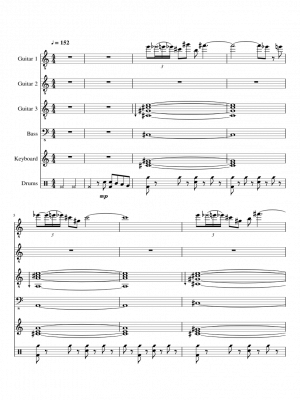

#Lilypond drums how to#
> The less simple things are how to represent the drum instruments and. > Doing a permanent implementation means doing a drum-head-engraver and an > auto-script-engraver (that automatically adds scripts to notes depending > on the pitch-information) > Both seems quite simple to do. TempoWholesPerMinute = #(ly:make-moment 90 4) addresshidden writes: > I have some issues hopefully to fix before 1.6. ly), including the lilypond-book-preamble.ly file (which LilyPond will know how to find): \version "2.16.2" % We don't need to require anything for this because lilypond-book will process it. lytex) to embed our music in: \documentclass\\ First lets create a LaTeX document (with the file extension. In the next lesson, we’ll look at how to customize the drum kit notation and why this is essential for modern drum notation.The LilyPond notation engraver can be used with LaTeX via the lilypond-book command. The process is the same, but we’ll just need to add an override for each voice. Now, let’s look at an example with two voices. In our groove example, the highest note represented (the hi-hat) is in the “1.5” space, so the stem for that note needs to be at 1.5 + 3.5, or 5. For footwork (bass drum), tap directly on the floor. To illustrate this, a snare note (which resides on the space directly above the center line, or 0.5) would need a stem that extends one octave (0.5 + 3.5 = 4). If you dont have a drum set at home, a practice pad, pillows or even your couch will do. This would equate to a numeric length of 3.5 using LilyPond’s number scheme. A properly written stem has a length of 1 octave, or 7 pitches. Using this number scheme, we can calulate the length that stems will need to be. These numbers can extend above and below the staff, so the first ledger line above the staff would have a numeric value of 3 and the space above that first ledger line would have a value of 3.5. The numbers for start and end can also be decimals, so the 4 spaces in the staff have the values -1.5, -0.5, 0.5, and 1.5 (again, from lowest to highest). Each line above the middle line adds 1 to the number, each line below removes 1 so the 5 lines on the staff have numeric values of -2, -1, 0, 1, and 2 (from lowest to highest). Attaching an extra symbol to the drum or restricting the number of lines is possible.
#Lilypond drums free#
Frescobaldi Frescobaldi is a free and open source LilyPond sheet music text. The middle line of the staff has a numeric value of 0. Using the powerful pre-configured tools such as the \drummode function and the DrumStaff context, inputting drum parts is quite easy: drums are placed at their own staff positions (with a special clef symbol) and have note heads according to the drum. Most Arduino based drum kits use the Arduino as input listener and midi. The numbers for start and end specify where the on the staff the beam will go.
#Lilypond drums full#
The command or full path to the lilypond executable must be correctly set for importing. The command to override the placement of beams is \override Beam #‘positions = #’( start. Percussion IDs: Which language to use for percussion instruments. The specification originates in the paper Universal Synthesizer Interface. It can refer to air quality, water quality, risk of getting respiratory disease or cancer. To correct this, we need to manually specify where beams will start and stop. MIDI (/ m d i / Musical Instrument Digital Interface) is a technical standard that describes a communications protocol, digital interface, and electrical connectors that connect a wide variety of electronic musical instruments, computers, and related audio devices for playing, editing, and recording music. The health of a city has many different factors.

\version "2.18.0"Īs you can see, the beams are correct for pitched music, but much harder to read for drum music.


Let’s start by looking at LilyPond’s default behavior with a simple groove. For this reason, most drum music uses fixed, even horizontal beams for beamed notes. Music for drums is made easier to read by making the beats and their subdivisions more clear rather than accentuating the rise and fall of pitches.


 0 kommentar(er)
0 kommentar(er)
